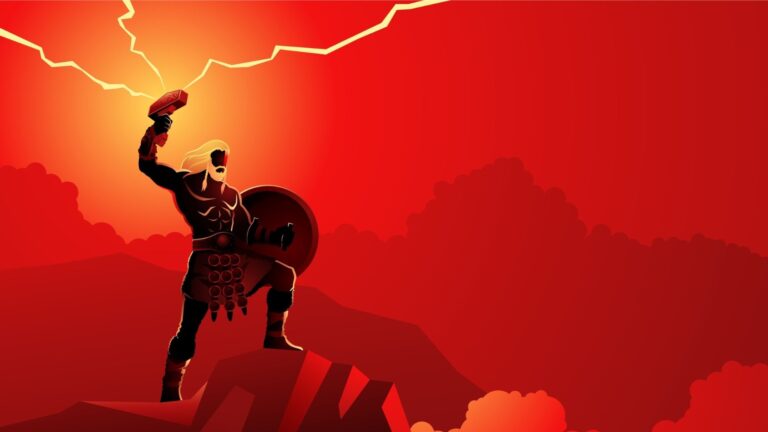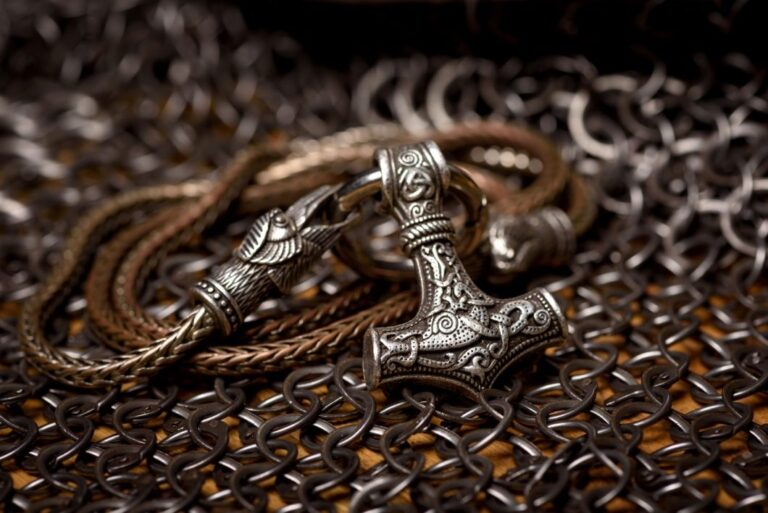Thor, the Norse god of thunder, remains a powerful symbol of strength and heroism. His tales of battling giants, his role in ensuring fertility and protection, and his enduring presence in popular culture underscore his significance in Norse mythology.
Known in Old Norse as Þórr, Thor is one of the most prominent figures in Norse mythology. Revered as the god of thunder, strength, and fertility, Thor is a quintessential symbol of might and heroism.

His tales of bravery and adventures resonate deeply with the values of courage and protection, making him a favourite among the gods in the pantheon of Norse mythology.
The Temperamental Thunder-God
Thor, often depicted with red hair and a bushy beard, embodies the storm and its fierce power.
He is the son of Odin, the “All-Father,” and Fjorgynn (or Jord), a giantess, making Thor half-giant. This lineage gives Thor his immense strength and connects him to both the divine and the primal forces of nature.
Thor is not only the god of thunder but also a guardian of farmers and free people. His protection extends to those who work the land, ensuring fertility and prosperity.
This dual role as a god of war and agriculture highlights his importance in maintaining order and abundance in the world.
Thor's Mighty Objects
Thor's power is augmented by three magical items: Mjölnir, Megingjord, and Járngreipr.

Mjölnir, his iconic hammer, is capable of devastating blows, returning to Thor’s hand after being thrown, and even resurrecting the dead in some myths.
Megingjord, his belt of strength, doubles Thor's already formidable power when worn. Járngreipr, a pair of iron gloves, allows him to handle Mjölnir’s immense power safely.
These objects symbolise Thor's readiness for battle and his role as a protector against the chaotic forces of the giants, or jötnar. His ability to wield these items effectively marks him as one of the strongest gods, a true warrior deity.
Thor's Family and Companions
Thor is married to Sif, a Norse goddess associated with fertility and family, known for her golden hair, which symbolizes fields of ripe grain. Together, they have a daughter named Thudr, who is thought to be a valkyrie.
Thor also has a son named Magni, with his giantess lover Járnsaxa, and another son, Módi, whose mother is not identified in surviving texts.
Thor’s chariot is drawn by two magical goats, Tanngrisnir and Tanngnjóstr. Remarkably, Thor can slaughter and eat these goats, then resurrect them with Mjölnir, highlighting his control over life and death and his resourcefulness.
Thor's Adventures
Thor's mythology is rich with tales of his battles and exploits. One of the most famous stories is the theft of Mjölnir, recounted in the Poetic Edda's Thrymskvida.

When the giant Thrym steals Mjölnir and demands Freyja's hand in marriage in exchange for its return, the gods devise a plan to disguise Thor as Freyja.
Despite his initial reluctance, Thor dons a bridal gown, travels to Jotunheim with Loki, and retrieves his hammer. Once Mjölnir is placed in his lap, Thor reveals his true identity and slaughters the giants, restoring order.
Another significant myth involves Thor’s fishing trip with the giant Hymir, where Thor attempts to capture Jormungandr, the Midgard Serpent. Though he hooks the serpent, Hymir cuts the line out of fear, preventing Thor from finishing the battle.
This encounter foreshadows their final clash during Ragnarok, the end of the world, where Thor and Jormungandr are destined to kill each other.
The Role of Thor in Norse Society
Thor's influence extended beyond myth into the daily lives of the Norse people. He was invoked for protection, blessing, and fertility.
His hammer, Mjölnir, was a powerful symbol, used in ceremonies to consecrate marriages, births, and agricultural activities. Miniature Mjölnir amulets have been found in archaeological sites, indicating the widespread veneration of Thor.

During the Viking Age, Thor's popularity soared, particularly among the common people and farmers. His straightforward, warrior-like approach to problems contrasted sharply with Odin’s more complex and sometimes deceitful nature.
Another reason for Thor's rising popularity was the arrival of Christianity in Scandinavia. As Christians sought to eradicate the old Norse religion, the locals, who initially tolerated the new faith, retaliated to defend their traditions.
Thor, symbolising the defense of their way of life, became a central figure in this resistance. This cultural struggle is evident in the archaeological findings of Thor’s hammer pendants worn in contrast to Christian cross amulets, particularly in areas with strong Christian influence.
Although the old ways ultimately declined, Thor's role as a divine patron provided a significant boost to the preservation of Norse traditions during this period.
Thor's prominence is also evident in the days of the week; “Thursday” is derived from “Thor’s day” (Þonares dagaz in Old Saxon). This naming convention highlights the lasting impact of Thor's worship on modern culture.
Thor in Popular Culture
As one of the leading Norse gods, Thor's legacy endures in modern times, most notably through his portrayal in the Marvel comic books and films.
The character of Thor has been brought to life on the big screen by Australian actor Chris Hemsworth, who first appeared as the god of thunder in the 2011 film “Thor.”
Hemsworth's portrayal has been widely acclaimed for capturing Thor's essence of bravery, strength, and humor, becoming one of the most recognizable faces of the Marvel Cinematic Universe (MCU).

Hemsworth's depiction of Thor has seen the character evolve over multiple films, including “The Avengers” series, “Thor: The Dark World,” “Thor: Ragnarok,” “Avengers: Infinity War,” “Avengers: Endgame,” and “Thor: Love and Thunder.”
Each film has added depth to Thor's character, exploring his journey from a brash warrior to a more introspective and self-aware hero. Hemsworth's performance balances Thor's godly might with a relatable human touch, endearing him to audiences worldwide.
While these adaptations take creative liberties, such as depicting Thor with blonde hair instead of his traditional red, they preserve his fundamental characteristics: bravery, strength, and his iconic hammer, Mjölnir.
The Marvel films have also introduced additional elements from Norse mythology, such as Thor's relationships with his father Odin, his mischievous brother Loki (played by Tom Hiddleston), and his battles against formidable foes.
These contemporary depictions have introduced Thor to a global audience, cementing his status as a cultural icon. The films have renewed interest in Norse mythology, inspiring people to explore the stories and legends that surround the god of thunder.
As both a divine warrior and a guardian of human society, Thor's legacy continues to inspire and captivate, making him a timeless figure in the rich tapestry of Norse legend.
The enduring popularity of the character, bolstered by Chris Hemsworth's charismatic portrayal, ensures that Thor remains a significant and beloved figure in popular culture.

